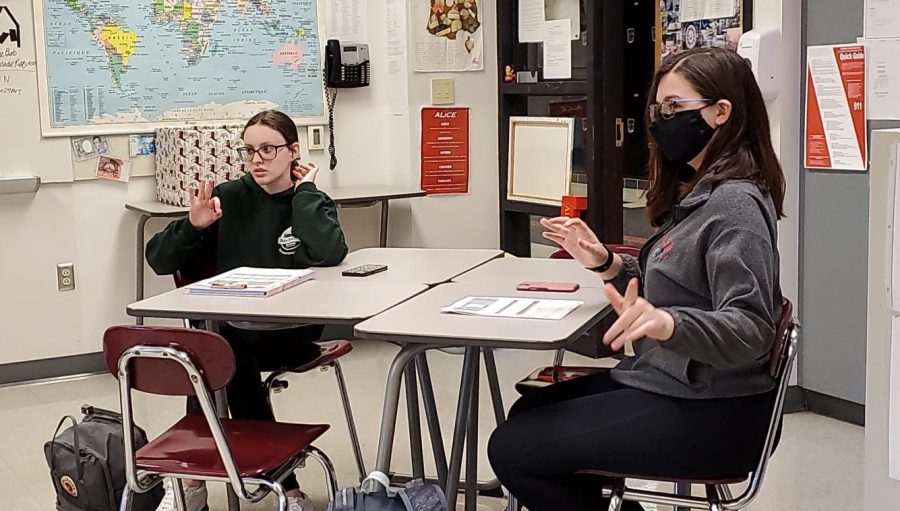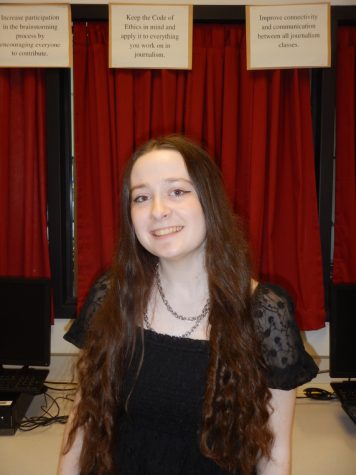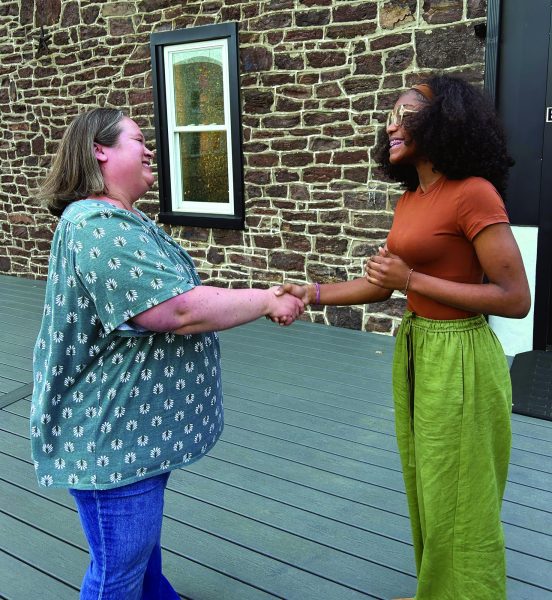American Sign Language Club hopes to expand horizons
To spread awareness of the deaf community and make sign language more accessible, the ASL club strives to teach students American sign language. Their goal is to have a class formed by the 2023-2024 school year.
Arrowhead Photo by Amanda Hill
Simple signing…Practicing their skills, ASL Club members Joslynn Riddle (left) and Ryan Miller use American Sign Language to say the newly learned phrase ‘three dogs’. This meeting was held after school on November 18.
By communicating with school administrators and gaining student interest, the ASL Club hopes to create an American Sign Language class to raise the awareness and accessibility of sign language education.
The ASL Club is one of over 50 available clubs at the high school. Meetings for this club are held on the second Tuesday and the third Thursday of the month from 3-4 p.m. The ASL Club introduces students to the American version of sign language.
Students and teachers alike hope to make ASL an available class in the future.
ASL Club advisor Anne Frederick believes that an ASL class would be a useful and realistic language course to implement.
“I think the administration sees the value of having ASL as a viable language. I think a lot of kids, too,” Frederick said. “It fits right into their pathway program because [using sign language is] something you [may] need to do, regardless of different careers.”
Students outside of the ASL Club believe that a class would be quite useful, as well.
“[ASL] would be a good addition to language classes since it can be very useful,” junior Gabriel Smola said.
According to Frederick, student interest is a rather large component behind the formation of an American Sign Language class.
“The only way they’ll run a class is if there’s student interest, so I’m hoping we can agenda that,” Frederick said.
ASL Club member Audrey Harman, holds the same thought.
“If it’s just advertised very well, it’ll be easy to get people to want to do it,” Harman said.
Smola believes that making the ASL Club into a class is what would draw student attention.
ASL Club founder Elizabeth Bywaters thinks that a class like this could help bridge the gap between the hearing and non-hearing communities.
“Sign language is not really known enough by people outside of the deaf community, which makes it really challenging to communicate,” Bywaters said.
Communication Service for the Deaf (CSD) statistics state that many in the deaf community do not have the access to sign language education either.
According to CSD, 98% of deaf people do not receive schooling in sign language.
Students and teachers alike have their own beliefs on why ASL is not an available language course. Sign language is used by those with hearing ailments, as well as people with other disabilities.
“Discrimination toward disabled people and ignoring them are why we don’t really branch out into those types of different languages like Braille and sign language,” Harman said.
Smola takes a different approach in his beliefs.
“ASL isn’t exactly what comes to mind when people think of language classes,” Smola said. “I also doubt there are as many people qualified to teach ASL as there are teachers for spoken languages.”
Frederick agrees with the idea that sign language is not often thought of when the topic of languages arises.
“It’s traditionally not done because the deaf community is part of us, and yet they’re so separate and apart. Now, we’re more about diversity, more about inclusion. [ASL] has never been what was considered traditional study,” Frederick said. “It’s not that people wanted to exclude it, it never was thought to be included.”
Frederick feels that diversity is another key component in the making of an ASL course.
“Diversity would be [having] someone on the staff who was born deaf,” Frederick said. “It’d be interesting to see how that works because we would have no one on staff that would interpret for them if they were at a faculty meeting.”
Frederick believes that American Sign Language will become extremely useful and necessary in the future.
“I think it’s almost more useful than Spanish, and everyone thinks ‘Oh, take Spanish, you’re going to need it someday,’” Frederick said. “I think you’re going to need sign [language] more than you’re going to need Spanish.”
According to Ai Media, there are around 138-300 varying types of sign language. Some languages have different versions.
“English for example, has three varieties: American Sign Language (ASL), British Sign Language (BSL) and Australian Sign Language (Auslan),” Ai Media said.
Ai Media is an Australian-based company that focuses on creating captions for live and pre-recorded television. They currently convert over 300,000 hours of content each year.






